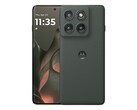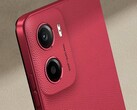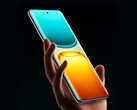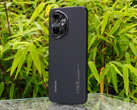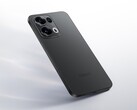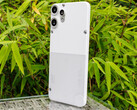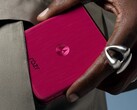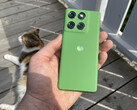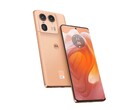Verdict on the Motorola Edge 60
The Motorola Edge 60 is one of the best smartphones you can get for up to $500. Highlights include its super bright P-OLED display at 120 Hz, good triple-camera system including a telephoto lens, long runtimes and fast charging, eSIM support, as well as 512 GB of storage including the option to expand this via a microSD card.
Its strong total package is rounded out by a very high-quality case with an IP69 certification. Its screen glass, which wraps over the edges of the device, is handy for displaying notifications—but apart from that, it's simply a matter of taste.
The installed MediaTek Dimensity 7300 delivers solid everyday performance, but it could do with being a little faster. The same can be said about the phone's storage. Motorola has saved some money in other areas, too. For example, the smartphone doesn't support wireless charging and despite its WiFi 6 support, its WLAN speeds are pretty poor. Adding to this is a rather meager update promise, as its support already ends in 2029, so in 4 years time.
Pros
Cons
Price and availability
At the time of writing, the Motorola Edge 60 is not available to purchase in the United States. In Europe, the phone retails for 430 euros (approx. $490).
Table of Contents
- Verdict on the Motorola Edge 60
- Specifications
- Case - The Motorola Edge 60 with an IP69 certification
- Connectivity - The Edge 60 with 12 GB RAM and up to 512 GB storage space
- Software - Android 15 with Moto AI and updates until 2029
- Communication and GNSS - The Edge 60 with WiFi 6, Bluetooth 5.4 and NFC
- Telephone functions and call quality - Dual-SIM support with nano SIM + eSIM
- Cameras - Triple-camera with OIS and 3x telephoto zoom
- Accessories and warranty - The Edge 60 without a power supply
- Input devices and operation - A 120 Hz screen and a fast fingerprint sensor
- Display - Super bright P-OLED screen at almost 4000 nits
- Performance - The Motorola Edge 60 with the MediaTek Dimensity 7300
- Games - Up to 60fps realistically
- Emissions - Full performance even under stress
- Battery life - Long runtimes and short charging times
- Notebookcheck total rating
- Possible alternatives compared
The Edge 60 is Motorola's newest mid-range smartphone, adopting quite a few features from its more expensive sibling, the Edge 60 Pro. Both mid-range phones are equipped with a curved P-OLED screen and have backs with leather and textile finishes. Plus, they both use a triple-camera with an optical 3x zoom.
The main differences between the two models lie in their processors and batteries. A MediaTek Dimensity 7300 runs inside the Edge 60, while the more powerful Dimensity 8350 can be found inside the Edge 60 Pro. Furthermore, the Pro model features a 6000 mAh battery, while the Edge 60 has to make do with 5200 mAh. As our test revealed, its runtimes are still excellent, and in general, the Edge 60 could very well prove to be the more interesting smartphone for potential buyers.
Specifications
Case - The Motorola Edge 60 with an IP69 certification
The Edge 60 feels like a real treat to hold in your hand. Weighing in at only 179 grams at a size of 6.67 inches, the smartphone feels super comfortable to hold. Plus, thanks to its display with rounded edges at the sides, which elegantly merges into the rubberized and grippy back cover, it feels like a much more expensive smartphone.
The stable and well-built Edge 60 can't be bent or dented, even when you apply lots of pressure. Moreover, it's IP69-certified, meaning the mid-range smartphone is protected against dust and water, while also being resistant to hot water and pressurized water jets. Its predecessor, the Edge 50, only had an IP68 certification.
In keeping with its product name, the device's display that extends over the edges gives the Edge 60 an impressive screen-to-body ratio of 96.3%. Its slightly roughened silicone back features a faux leather finish in the green Pantone Shamrock color variant, and the blue Pantone Gibraltar Sea color has a fabric cover. In other regions, the smartphone is also available in a third color variant, a violet color called Pantone Plumperfect.
Connectivity - The Edge 60 with 12 GB RAM and up to 512 GB storage space
The Edge 60 has 12 GB of RAM and 512 GB of storage. Motorola doesn't officially offer its smartphone in other storage variants, at least in the EU, where this test was carried out. Despite this, another version is available online with 12 GB RAM and 256 GB storage space.
The phone's internal storage can be expanded by using the microSD card slot, which can hold cards up to 1 TB in size. In addition to a microSD card, a nano SIM card fits into the card slot, and users can activate an eSIM for dual SIM operation. The device also comes equipped with stereo speakers. The Edge 60's USB-C port is limited to USB 2.0 speeds.
microSD card reader
The Edge 60's microSD card reader achieves decent speeds. In our copying test alongside our Angelbird AV Pro V60 reference card, it managed an above-average 40 MByte/s on average. Data transfers were fairly stable both when reading and writing.
| SD Card Reader - average JPG Copy Test (av. of 3 runs) | |
| Motorola Edge 60 | |
| Average of class Smartphone (5.72 - 58.9, n=67, last 2 years) | |
Cross Platform Disk Test (CPDT)
Software - Android 15 with Moto AI and updates until 2029
The Edge 50 was launched with Android 15 and is set to receive security updates every two months until March 2029, so for 4 years in total. OS upgrades will be delivered for 3 years. This is fine, however, Samsung and Google have certainly set the benchmark in this respect, with an update timeframe of 6 and 7 years, respectively.
Motorola has left the preinstalled Android 15 mostly unchanged. The few third-party apps that are on the phone can be uninstalled and the manufacturer has outsourced its in-house functions to its own apps. These include the AI assistant Moto AI, which is designed to support users during everyday life. However, it only provides its services if you have a Motorola account.
The AI tool is launched by double-tapping the power button and it can then summarize messages and missed calls, optimize photos, transcribe audio recordings (menu item Pay Attention) and save notes including screenshots and photos (Remember), among other things.
Moto AI can be conveniently controlled by voice commands, but it currently only works smoothly if you speak to the AI in English, Spanish or Portuguese. Hopefully this will change with an update and more functions will be added.
Sustainability
The Edge 60 comes in paper packaging that bears the FSC Mix label (Forest Stewardship Council). This stands for products that use recycled materials and/or materials from FSC-certified forests. Its packaging has been printed with soy ink.
Although Motorola provides comprehensive information about its sustainability initiatives on its website, no details about the smartphone's carbon footprint could be found at the time of testing. Spare parts and instructions for self-repair are also not available.
Communication and GNSS - The Edge 60 with WiFi 6, Bluetooth 5.4 and NFC
In addition to WiFi 6, the Edge 60 supports Bluetooth 5.4 and NFC. Plus, it supports a good variety of cellular frequencies, so you shouldn't face many reception issues further afield.
Using WiFi 6, the Motorola smartphone is still limited to the 2.4 GHz and 5 GHz bands, which is generally not a problem. However, compared to the WiFi 6E-ready Edge 50, this marks a step backward and isn't enough to impress the competition in any way. Connected to our Asus ROG Rapture GT-AXE11000, the Edge 60 only reached a maximum WLAN speed of 372 MBit/s.
| Networking | |
| Motorola Edge 60 | |
| iperf3 transmit AXE11000 | |
| iperf3 receive AXE11000 | |
| Motorola Edge 50 | |
| iperf3 transmit AXE11000 | |
| iperf3 receive AXE11000 | |
| iperf3 transmit AXE11000 6GHz | |
| iperf3 receive AXE11000 6GHz | |
| Nothing Phone (3a) | |
| iperf3 transmit AXE11000 | |
| iperf3 receive AXE11000 | |
| OnePlus Nord 4 | |
| iperf3 transmit AXE11000 | |
| iperf3 receive AXE11000 | |
| Samsung Galaxy A36 5G | |
| iperf3 transmit AXE11000 | |
| iperf3 receive AXE11000 | |
| Xiaomi Poco X7 | |
| iperf3 transmit AXE11000 | |
| iperf3 receive AXE11000 | |
| Average 802.11 a/b/g/n/ac/ax | |
| iperf3 transmit AXE11000 | |
| iperf3 receive AXE11000 | |
| iperf3 transmit AXE11000 6GHz | |
| iperf3 receive AXE11000 6GHz | |
| Average of class Smartphone | |
| iperf3 transmit AXE11000 | |
| iperf3 receive AXE11000 | |
| iperf3 transmit AXE11000 6GHz | |
| iperf3 receive AXE11000 6GHz | |
The Edge 60's satellite positioning works fast and precisely, making the smartphone a good navigation device.
Compared to the Garmin Venu 2 fitness smartwatch, it delivered one or two inaccuracies during our test bike trip but even so, it recorded our actual route almost as precisely and didn't let itself get misguided by narrow old-town alleyways.
Telephone functions and call quality - Dual-SIM support with nano SIM + eSIM
For making calls, the Edge 60 uses the standard app from Android. Aside from VoLTE, the phone also supports WLAN calls. During our test, the smartphone delivered good call quality and transmitted our voice clearly to the person on the other end of the line—even in louder environments. The same can be said for using the hands-free mode, as long as you don't speak too quietly.
Cameras - Triple-camera with OIS and 3x telephoto zoom
The phone's photography options are comparatively plentiful, as aside from a 50 MP main camera and an ultra-wide angle lens bearing the same resolution, the Motorola smartphone features a 10 MP telephoto camera, which isn't the norm in this price range. Together, this results in a focal length range of 12 to 73 millimeters.
Like its main lens, the telephoto camera is equipped with an optical image stabilizer. It can access a 3x optical zoom and takes good pictures in daylight. Digital zoom rates of up to 30x are supported, but this makes the subjects look quite blurry.
Photos taken using the main camera and ultra-wide-angle lens look similarly good and boast a good level of sharpness. In low-light conditions, they still show a comparatively large amount of detail. In general, the camera software focuses on vivid colors and high contrasts, which sometimes makes the photos look quite vibrant—you have to like the style. The smartphone records videos in similarly good quality at up to 4K at 30 frames per second and works with a fast autofocus and good exposure compensation.
There is a 50 MP selfie camera on the front, which takes very good photos. It is right at the top of the mid-range segment when it comes to the level of detail, sharpness, color and illumination. It can record videos at up to 4K at 30 frames per second.
Image comparison
Choose a scene and navigate within the first image. One click changes the position on touchscreens. One click on the zoomed-in image opens the original in a new window. The first image shows the scaled photograph of the test device.
Daylight photoDaylight photoUltra-wide angleLow-light photoWe took another close look at the phone's main camera in our test lab. In optimum lighting conditions, it depicted colors realistically and was able to reproduce the test chart sharply. In 1 lux of residual light, it only depicted the latter diffusely, but it remained recognizable as a whole.

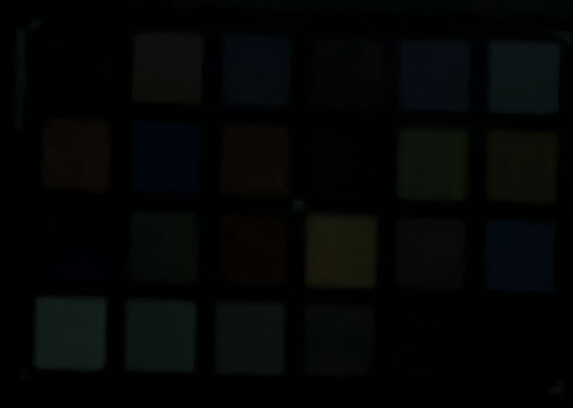
Accessories and warranty - The Edge 60 without a power supply
Motorola doesn't deliver a power supply with its Edge 60. Its scope of delivery includes a USB-C cable, a plastic protective case, a SIM tool, as well as a short instruction manual.
The manufacturer's phones are covered by a standard 12-month warranty in the USA. Buyers have the option to extend this to up to 3 years via Moto Care. Depending on the package, this costs between $20 and $99.
Input devices and operation - A 120 Hz screen and a fast fingerprint sensor
Thanks to its 120 Hz display, which is scanned up to 300 times per second in gaming mode, the Edge 60 can be operated very smoothly. The P-OLED touchscreen reliably recognizes inputs right into the corners and along the edges. If the smartphone is placed with the display side on the table, the Edge 60 can light up the edges of its screen for notifications, calls and when the alarm clock is activated.
The fingerprint sensor located under the panel recognizes registered prints super quickly and then unlocks the smartphone with almost no delay. The 2D facial recognition using the selfie camera is practically just as fast in sufficiently bright ambient light.
Display - Super bright P-OLED screen at almost 4000 nits
According to Motorola, the Edge 60's 6.67-inch P-OLED screen can reach a brightness of up to 4500 cd/m². When displaying small image excerpts (APL18 measurement), we could elicit a maximum of 3923 cd/m² from the display, which is still a great level of brightness. We noted up to 1362 cd/m² when showing an all-white background, resulting in the Edge 60 outperforming all of the comparison devices.
The P-OLED screen flickers at a relatively high PWM frequency of 742 Hz with an amplitude of 30 percent across all of the brightness levels that we measured. Sensitive users could still be impacted by this and should therefore try out the smartphone before buying it.
| |||||||||||||||||||||||||
Brightness Distribution: 95 %
Center on Battery: 1362 cd/m²
Contrast: ∞:1 (Black: 0 cd/m²)
ΔE ColorChecker Calman: 0.93 | ∀{0.5-29.43 Ø4.78}
ΔE Greyscale Calman: 1.2 | ∀{0.09-98 Ø5}
104% sRGB (Calman 2D)
Gamma: 2.201
CCT: 6585 K
| Motorola Edge 60 P-OLED, 2712x1220, 6.7" | Motorola Edge 50 P-OLED, 2712x1220, 6.7" | Nothing Phone (3a) AMOLED, 2392x1080, 6.8" | OnePlus Nord 4 AMOLED, 2772x1240, 6.7" | Samsung Galaxy A36 5G Super AMOLED, 2340x1080, 6.7" | Xiaomi Poco X7 AMOLED, 2712x1220, 6.7" | |
|---|---|---|---|---|---|---|
| Screen | -37% | -119% | -55% | -44% | -27% | |
| Brightness middle (cd/m²) | 1362 | 1164 -15% | 1287 -6% | 1102 -19% | 1127 -17% | 1156 -15% |
| Brightness (cd/m²) | 1336 | 1156 -13% | 1274 -5% | 1102 -18% | 1137 -15% | 1150 -14% |
| Brightness Distribution (%) | 95 | 95 0% | 97 2% | 94 -1% | 98 3% | 98 3% |
| Black Level * (cd/m²) | ||||||
| Colorchecker dE 2000 * | 0.93 | 1.14 -23% | 1.9 -104% | 1.43 -54% | 1.8 -94% | 1.1 -18% |
| Colorchecker dE 2000 max. * | 1.69 | 3.46 -105% | 8.7 -415% | 4.04 -139% | 2.8 -66% | 3.1 -83% |
| Greyscale dE 2000 * | 1.2 | 2 -67% | 3.4 -183% | 2.4 -100% | 2.1 -75% | 1.6 -33% |
| Gamma | 2.201 100% | 2.213 99% | 2.26 97% | 2.213 99% | 2.11 104% | 2.22 99% |
| CCT | 6585 99% | 6553 99% | 7072 92% | 6385 102% | 6466 101% | 6304 103% |
* ... smaller is better
Screen Flickering / PWM (Pulse-Width Modulation)
| Screen flickering / PWM detected | 742 Hz Amplitude: 30 % | ||
The display backlight flickers at 742 Hz (worst case, e.g., utilizing PWM) . The frequency of 742 Hz is quite high, so most users sensitive to PWM should not notice any flickering. In comparison: 53 % of all tested devices do not use PWM to dim the display. If PWM was detected, an average of 8108 (minimum: 5 - maximum: 343500) Hz was measured. | |||
Measurement series with fixed zoom level and different brightness settings (The amplitude curve at minimum brightness looks flat, but this is due to the scaling. The info box shows the enlarged version of the amplitude at minimum brightness).
When analyzed with our photo spectrometer and Calman software, the display showed its best side. Using the preset color mode Natural, all image parameters were clearly on target and 76% of the large DCI-P3 and AdobeRGB color spaces were still covered.
Display Response Times
| ↔ Response Time Black to White | ||
|---|---|---|
| 2 ms ... rise ↗ and fall ↘ combined | ↗ 0.9 ms rise | |
| ↘ 1.1 ms fall | ||
| The screen shows very fast response rates in our tests and should be very well suited for fast-paced gaming. In comparison, all tested devices range from 0.1 (minimum) to 240 (maximum) ms. » 10 % of all devices are better. This means that the measured response time is better than the average of all tested devices (20.2 ms). | ||
| ↔ Response Time 50% Grey to 80% Grey | ||
| 2.4 ms ... rise ↗ and fall ↘ combined | ↗ 1.2 ms rise | |
| ↘ 1.2 ms fall | ||
| The screen shows very fast response rates in our tests and should be very well suited for fast-paced gaming. In comparison, all tested devices range from 0.165 (minimum) to 636 (maximum) ms. » 10 % of all devices are better. This means that the measured response time is better than the average of all tested devices (31.6 ms). | ||
The Edge 60 does really well outdoors. Its viewing angle-stable P-OLED screen has enough brightness to outshine reflections even on bright sunny days. Even so, its curved surface means that reflections cannot be completely ruled out, so screen content is always displayed a little more clearly in the shade.
Performance - The Motorola Edge 60 with the MediaTek Dimensity 7300
Equipped with the MediaTek Dimensity 7300, the Edge 60 develops solid mid-range performance and almost always ensures smooth operation in everyday use. Moreover, the SoC's performance was sufficient to beat many a competitor during our test. In markets outside the EU, Motorola also sells some of its smartphones with the MediaTek Dimensity 7400 SoC.
| UL Procyon AI Inference for Android - Overall Score NNAPI | |
| Motorola Edge 60 | |
| Average MediaTek Dimensity 7300 (8087 - 27964, n=8) | |
| Average of class Smartphone (3769 - 81594, n=135, last 2 years) | |
| OnePlus Nord 4 | |
| Nothing Phone (3a) | |
| Xiaomi Poco X7 | |
| Samsung Galaxy A36 5G | |
With the ARM GPU Mali-G615 MP2 as its pixel generator, the Edge 60 also ranked in the midfield in the GPU benchmarks. Overall, it came quite close to the Samsung Galaxy A36 5G, but without being able to surpass its performance. If gaming is of utmost importance to you, then other mid-range smartphones such as the OnePlus Nord 4 may be a better choice.
GFXBench (DX / GLBenchmark) 2.7: T-Rex Onscreen | 1920x1080 T-Rex Offscreen
GFXBench 3.0: on screen Manhattan Onscreen OGL | 1920x1080 1080p Manhattan Offscreen
GFXBench 3.1: on screen Manhattan ES 3.1 Onscreen | 1920x1080 Manhattan ES 3.1 Offscreen
GFXBench: on screen Car Chase Onscreen | 1920x1080 Car Chase Offscreen | on screen Aztec Ruins High Tier Onscreen | 2560x1440 Aztec Ruins High Tier Offscreen | on screen Aztec Ruins Normal Tier Onscreen | 1920x1080 Aztec Ruins Normal Tier Offscreen | 3840x2160 4K Aztec Ruins High Tier Offscreen
| 3DMark / Wild Life Extreme Unlimited | |
| OnePlus Nord 4 | |
| Nothing Phone (3a) | |
| Samsung Galaxy A36 5G | |
| Motorola Edge 60 | |
| Xiaomi Poco X7 | |
| Motorola Edge 50 | |
| 3DMark / Wild Life Extreme | |
| OnePlus Nord 4 | |
| Nothing Phone (3a) | |
| Samsung Galaxy A36 5G | |
| Motorola Edge 60 | |
| Xiaomi Poco X7 | |
| Motorola Edge 50 | |
| 3DMark / Wild Life Unlimited Score | |
| OnePlus Nord 4 | |
| Nothing Phone (3a) | |
| Samsung Galaxy A36 5G | |
| Motorola Edge 50 | |
| Motorola Edge 60 | |
| Xiaomi Poco X7 | |
| 3DMark / Steel Nomad Light Unlimited Score | |
| OnePlus Nord 4 | |
| Nothing Phone (3a) | |
| Xiaomi Poco X7 | |
| Motorola Edge 60 | |
| Motorola Edge 50 | |
| 3DMark / Steel Nomad Light Score | |
| OnePlus Nord 4 | |
| Nothing Phone (3a) | |
| Motorola Edge 60 | |
| Xiaomi Poco X7 | |
| Motorola Edge 50 | |
| GFXBench (DX / GLBenchmark) 2.7 / T-Rex Onscreen | |
| Samsung Galaxy A36 5G | |
| Motorola Edge 60 | |
| Xiaomi Poco X7 | |
| OnePlus Nord 4 | |
| Nothing Phone (3a) | |
| GFXBench (DX / GLBenchmark) 2.7 / T-Rex Offscreen | |
| OnePlus Nord 4 | |
| Nothing Phone (3a) | |
| Samsung Galaxy A36 5G | |
| Xiaomi Poco X7 | |
| Motorola Edge 60 | |
| GFXBench 3.0 / Manhattan Onscreen OGL | |
| Samsung Galaxy A36 5G | |
| Motorola Edge 60 | |
| OnePlus Nord 4 | |
| Xiaomi Poco X7 | |
| Nothing Phone (3a) | |
| GFXBench 3.0 / 1080p Manhattan Offscreen | |
| OnePlus Nord 4 | |
| Nothing Phone (3a) | |
| Motorola Edge 60 | |
| Xiaomi Poco X7 | |
| Samsung Galaxy A36 5G | |
| GFXBench 3.1 / Manhattan ES 3.1 Onscreen | |
| OnePlus Nord 4 | |
| Nothing Phone (3a) | |
| Samsung Galaxy A36 5G | |
| Xiaomi Poco X7 | |
| Motorola Edge 60 | |
| GFXBench 3.1 / Manhattan ES 3.1 Offscreen | |
| OnePlus Nord 4 | |
| Nothing Phone (3a) | |
| Xiaomi Poco X7 | |
| Samsung Galaxy A36 5G | |
| Motorola Edge 60 | |
| GFXBench / Car Chase Onscreen | |
| OnePlus Nord 4 | |
| Nothing Phone (3a) | |
| Samsung Galaxy A36 5G | |
| Motorola Edge 60 | |
| Xiaomi Poco X7 | |
| GFXBench / Car Chase Offscreen | |
| OnePlus Nord 4 | |
| Nothing Phone (3a) | |
| Xiaomi Poco X7 | |
| Motorola Edge 60 | |
| Samsung Galaxy A36 5G | |
| GFXBench / Aztec Ruins High Tier Onscreen | |
| OnePlus Nord 4 | |
| Nothing Phone (3a) | |
| Samsung Galaxy A36 5G | |
| Motorola Edge 50 | |
| Motorola Edge 60 | |
| Xiaomi Poco X7 | |
| GFXBench / Aztec Ruins High Tier Offscreen | |
| OnePlus Nord 4 | |
| Nothing Phone (3a) | |
| Samsung Galaxy A36 5G | |
| Motorola Edge 50 | |
| Xiaomi Poco X7 | |
| Motorola Edge 60 | |
| GFXBench / Aztec Ruins Normal Tier Onscreen | |
| OnePlus Nord 4 | |
| Nothing Phone (3a) | |
| Samsung Galaxy A36 5G | |
| Motorola Edge 60 | |
| Motorola Edge 50 | |
| Xiaomi Poco X7 | |
| GFXBench / Aztec Ruins Normal Tier Offscreen | |
| OnePlus Nord 4 | |
| Nothing Phone (3a) | |
| Samsung Galaxy A36 5G | |
| Motorola Edge 50 | |
| Xiaomi Poco X7 | |
| Motorola Edge 60 | |
| GFXBench / 4K Aztec Ruins High Tier Offscreen | |
| OnePlus Nord 4 | |
| Nothing Phone (3a) | |
| Motorola Edge 50 | |
| Samsung Galaxy A36 5G | |
| Xiaomi Poco X7 | |
| Motorola Edge 60 | |
The Edge 60 is a speedy companion when surfing the web, as web pages load quickly and are displayed swiftly. However, its benchmark results were once again only average.
| Jetstream 2 - 2.0 Total Score | |
| Nothing Phone (3a) (Chrome 134.0.6998.135) | |
| Average of class Smartphone (23.8 - 387, n=149, last 2 years) | |
| Samsung Galaxy A36 5G (Chrome 135) | |
| OnePlus Nord 4 (Chrome 127) | |
| Motorola Edge 60 (Chrome 136.0.7103.125) | |
| Average MediaTek Dimensity 7300 (60.2 - 138.5, n=7) | |
| Xiaomi Poco X7 (Chrome 132.0.6834.163) | |
| Speedometer 2.0 - Result 2.0 | |
| Average of class Smartphone (15.2 - 643, n=122, last 2 years) | |
| Nothing Phone (3a) (Chrome 134.0.6998.135) | |
| Motorola Edge 60 (Chrome 136.0.7103.125) | |
| Average MediaTek Dimensity 7300 (76.5 - 143, n=7) | |
| OnePlus Nord 4 (Chrome 127) | |
| Xiaomi Poco X7 (Chrome 132.0.6834.163) | |
| Samsung Galaxy A36 5G (Chrome 135) | |
| Speedometer 3 - Score 3.0 | |
| Average of class Smartphone (1.03 - 42.8, n=124, last 2 years) | |
| Nothing Phone (3a) (Chrome 134.0.6998.135) | |
| OnePlus Nord 4 (Chrome 127) | |
| Motorola Edge 60 (Chrome 136.0.7103.125) | |
| Average MediaTek Dimensity 7300 (5.6 - 8.86, n=8) | |
| Samsung Galaxy A36 5G (Chrome 135) | |
| Xiaomi Poco X7 (Chrome 132.0.6834.163) | |
| WebXPRT 4 - Overall | |
| Nothing Phone (3a) (Chrome 134.0.6998.135) | |
| Average of class Smartphone (27 - 306, n=145, last 2 years) | |
| Samsung Galaxy A36 5G (Chrome 135) | |
| Motorola Edge 60 (Chrome 136.0.7103.125) | |
| OnePlus Nord 4 (Chrome 127) | |
| Average MediaTek Dimensity 7300 (56 - 120, n=8) | |
| Xiaomi Poco X7 (Chrome 132.0.6834.163) | |
| Octane V2 - Total Score | |
| OnePlus Nord 4 (Chrome 127) | |
| Average of class Smartphone (2228 - 121337, n=197, last 2 years) | |
| Nothing Phone (3a) (Chrome 134.0.6998.135) | |
| Motorola Edge 60 (Chrome 136.0.7103.125) | |
| Samsung Galaxy A36 5G (Chrome 135) | |
| Average MediaTek Dimensity 7300 (22739 - 40600, n=12) | |
| Motorola Edge 50 (Chrome 128) | |
| Xiaomi Poco X7 (Chrome 132.0.6834.163) | |
| Mozilla Kraken 1.1 - Total | |
| Xiaomi Poco X7 | |
| Average MediaTek Dimensity 7300 (1060 - 2154, n=8) | |
| OnePlus Nord 4 (Chrome 127) | |
| Average of class Smartphone (257 - 28190, n=154, last 2 years) | |
| Motorola Edge 60 (Chrome 136.0.7103.125) | |
| Samsung Galaxy A36 5G (Chrome 135) | |
| Nothing Phone (3a) (Chrome 134.0.6998.135) | |
* ... smaller is better
The Edge 60 uses UFS storage, which combines DRAM and flash storage into one package (uMCP, Universal Flash Storage Multichip Package), which is primarily intended to reduce power consumption. As the AndroBench tests showed, it is about as fast as UFS 2.2 storage. Although its loading times remained relatively short, the smartphone didn't achieve a particularly high data throughput compared to the competition.
| Motorola Edge 60 | Motorola Edge 50 | Nothing Phone (3a) | OnePlus Nord 4 | Samsung Galaxy A36 5G | Xiaomi Poco X7 | Average 512 GB UFS 2.2 Flash | Average of class Smartphone | |
|---|---|---|---|---|---|---|---|---|
| AndroBench 3-5 | 13% | 5% | 131% | -42% | -18% | 0% | 72% | |
| Sequential Read 256KB (MB/s) | 970.1 | 1002.6 3% | 1031.34 6% | 3592.8 270% | 968.34 0% | 947.4 -2% | 1026 ? 6% | 2228 ? 130% |
| Sequential Write 256KB (MB/s) | 791.35 | 909.6 15% | 1001.28 27% | 2898.2 266% | 166.77 -79% | 915.23 16% | 930 ? 18% | 1851 ? 134% |
| Random Read 4KB (MB/s) | 258.29 | 296.6 15% | 245.48 -5% | 250.4 -3% | 233.98 -9% | 100.16 -61% | 234 ? -9% | 296 ? 15% |
| Random Write 4KB (MB/s) | 305.41 | 358.3 17% | 285.24 -7% | 276.2 -10% | 62.58 -80% | 226.88 -26% | 261 ? -15% | 337 ? 10% |
Games - Up to 60fps realistically
Although the ARM Mali-G615 MP2 inside the Edge 60 isn't a particularly powerful pixel producer, the Motorola smartphone is still suitable for gaming.
With Gamebench, we measured a smooth 60 frames per second when running PUBG Mobile at the lowest detail level, and a stable 40fps using the medium graphics settings. During Genshin Impact, it still managed a playable 30 frames per second even at the highest detail level.
Emissions - Full performance even under stress
Temperature
In terms of temperatures, the Edge 60 had everything under control during our test. Under continuous load, it heated up to over 44 °C at certain points on its surface, which was clearly noticeable with the smartphone held in our hand. Still, this is completely harmless in thermal terms and such an extreme scenario should rarely occur during everyday life. In addition, we noted no internal throttling, as the Edge 60 was able to deliver its full performance at practically any time, no matter how hard we pushed it.
(±) The maximum temperature on the upper side is 44.3 °C / 112 F, compared to the average of 35.2 °C / 95 F, ranging from 21.9 to 247 °C for the class Smartphone.
(±) The bottom heats up to a maximum of 44.6 °C / 112 F, compared to the average of 34 °C / 93 F
(+) In idle usage, the average temperature for the upper side is 24.8 °C / 77 F, compared to the device average of 32.9 °C / 91 F.
3DMark Steel Nomad stress test
| 3DMark | |
| Wild Life Stress Test Stability | |
| Motorola Edge 50 | |
| Nothing Phone (3a) | |
| Xiaomi Poco X7 | |
| Samsung Galaxy A36 5G | |
| Motorola Edge 60 | |
| OnePlus Nord 4 | |
| Wild Life Extreme Stress Test | |
| Nothing Phone (3a) | |
| Motorola Edge 50 | |
| Xiaomi Poco X7 | |
| Motorola Edge 60 | |
| Samsung Galaxy A36 5G | |
| OnePlus Nord 4 | |
| Steel Nomad Light Stress Test Stability | |
| Nothing Phone (3a) | |
| Motorola Edge 60 | |
| Motorola Edge 50 | |
| Xiaomi Poco X7 | |
| OnePlus Nord 4 | |
Speakers
The Motorola phone produces a good sound for this price range thanks to its stereo speakers. It lacks bass, and trebles dominate the sound mix—making voices in particular very clear to understand.
External audio devices can be connected via USB-C and Bluetooth 5.4. The Edge 60 supports many current Bluetooth codecs, namely SBC, AAC, aptX, aptX HD, aptX Adaptive, aptX TWS+, LDAC, LC3, Opus and LHDC V1-V5.
Motorola Edge 60 audio analysis
(+) | speakers can play relatively loud (84 dB)
Bass 100 - 315 Hz
(-) | nearly no bass - on average 23.5% lower than median
(±) | linearity of bass is average (11.9% delta to prev. frequency)
Mids 400 - 2000 Hz
(+) | balanced mids - only 4.3% away from median
(+) | mids are linear (5% delta to prev. frequency)
Highs 2 - 16 kHz
(+) | balanced highs - only 3.6% away from median
(+) | highs are linear (6.7% delta to prev. frequency)
Overall 100 - 16.000 Hz
(±) | linearity of overall sound is average (19% difference to median)
Compared to same class
» 24% of all tested devices in this class were better, 9% similar, 67% worse
» The best had a delta of 11%, average was 35%, worst was 134%
Compared to all devices tested
» 44% of all tested devices were better, 8% similar, 48% worse
» The best had a delta of 4%, average was 24%, worst was 134%
Samsung Galaxy A36 5G audio analysis
(+) | speakers can play relatively loud (90.5 dB)
Bass 100 - 315 Hz
(-) | nearly no bass - on average 26.4% lower than median
(±) | linearity of bass is average (7.3% delta to prev. frequency)
Mids 400 - 2000 Hz
(±) | reduced mids - on average 6.1% lower than median
(+) | mids are linear (4.3% delta to prev. frequency)
Highs 2 - 16 kHz
(+) | balanced highs - only 3% away from median
(+) | highs are linear (1.8% delta to prev. frequency)
Overall 100 - 16.000 Hz
(±) | linearity of overall sound is average (17.9% difference to median)
Compared to same class
» 15% of all tested devices in this class were better, 8% similar, 76% worse
» The best had a delta of 11%, average was 35%, worst was 134%
Compared to all devices tested
» 36% of all tested devices were better, 8% similar, 56% worse
» The best had a delta of 4%, average was 24%, worst was 134%
Battery life - Long runtimes and short charging times
Power consumption
The phone's 5200 mAh battery can be charged at up to 68 watts via a suitable power supply unit. During our test, we used the Anker 317 (100 watts), with which the Edge 60 managed a full charging cycle in just 50 minutes. It took 18 minutes to recharge to 50 percent and only 31 minutes to bring its battery level up to 80 percent.
| Off / Standby | |
| Idle | |
| Load |
|
Key:
min: | |
| Motorola Edge 60 5200 mAh | Nothing Phone (3a) 5000 mAh | OnePlus Nord 4 5500 mAh | Samsung Galaxy A36 5G 5000 mAh | Xiaomi Poco X7 5110 mAh | Average MediaTek Dimensity 7300 | Average of class Smartphone | |
|---|---|---|---|---|---|---|---|
| Power Consumption | 17% | -1% | -6% | 14% | 9% | -6% | |
| Idle Minimum * (Watt) | 1 | 0.93 7% | 0.9 10% | 0.86 14% | 1.09 -9% | 1.037 ? -4% | 0.842 ? 16% |
| Idle Average * (Watt) | 1.5 | 1.67 -11% | 1.1 27% | 1.75 -17% | 1.28 15% | 1.454 ? 3% | 1.439 ? 4% |
| Idle Maximum * (Watt) | 1.9 | 1.68 12% | 1.5 21% | 1.82 4% | 1.31 31% | 1.747 ? 8% | 1.624 ? 15% |
| Load Average * (Watt) | 5.6 | 3.69 34% | 6.7 -20% | 5.31 5% | 3.25 42% | 3.87 ? 31% | 7.03 ? -26% |
| Load Maximum * (Watt) | 8 | 4.75 41% | 11.3 -41% | 10.95 -37% | 8.62 -8% | 7.58 ? 5% | 11.3 ? -41% |
* ... smaller is better
Power consumption: Geekbench (150 cd/m²)
Power consumption: GFXbench (150 cd/m²)
Runtimes
Managing just over 20 hours of simulated web surfing and over 23 hours when playing an HD video in a continuous loop, the Edge 60 achieved very good battery runtimes during our test. In practice, the Motorola smartphone should be able to survive two days at a time away from a power outlet, even with intensive use. Among the comparison devices, the Nothing Phone (3a) and the OnePlus Nord 4 delivered similar endurance.
| Motorola Edge 60 5200 mAh | Motorola Edge 50 5000 mAh | Nothing Phone (3a) 5000 mAh | OnePlus Nord 4 5500 mAh | Samsung Galaxy A36 5G 5000 mAh | Xiaomi Poco X7 5110 mAh | |
|---|---|---|---|---|---|---|
| Battery runtime | -21% | 1% | 0% | -11% | -14% | |
| Reader / Idle (h) | 38.8 | 42.8 10% | 34.6 -11% | 33.4 -14% | ||
| H.264 (h) | 23.2 | 26.8 16% | 23.8 3% | 24.3 5% | ||
| WiFi v1.3 (h) | 20.3 | 16.1 -21% | 20.6 1% | 16.6 -18% | 14.8 -27% | 17.5 -14% |
| Load (h) | 4.8 | 3.6 -25% | 6.1 27% | 4.5 -6% |
Notebookcheck total rating
Motorola's Edge 60 is giving the mid-range competition a run for its money. The 6.67-inch smartphone fits into the upper class with its high-quality finish and wide range of features. In terms of performance, however, it once again only offers standard fare.
Motorola Edge 60
- 06/07/2025 v8
Manuel Masiero
Possible alternatives compared
Image | Model / Review | Price | Weight | Drive | Display |
|---|---|---|---|---|---|
| Motorola Edge 60 MediaTek Dimensity 7300 ⎘ ARM Mali-G615 MP2 ⎘ 12 GB Memory, 512 GB UFS 2.1 | Amazon: 1. $595.89 Motorola Moto Edge 60 Pro 5G... 2. $6.98 Natbok 2 Pack 3D Compatible ... 3. $8.88 LXEEOLX [2 Pack Hydrogel Scr... List Price: 429.99 Euro | 179 g | 512 GB UFS 2.2 Flash | 6.67" 2712x1220 446 PPI P-OLED | |
| Motorola Edge 50 Qualcomm Snapdragon 7 Gen 1 ⎘ Qualcomm Adreno 644 ⎘ 12 GB Memory, 512 GB UFS 2.1 | Amazon: 1. $229.72 Motorola Edge | 2024 | Unloc... 2. $419.50 Motorola Edge 50 Pro Dual-SI... 3. $275.00 Motorola Moto Edge 50 Fusion... List Price: 600€ | 180 g | 512 GB UFS 2.2 Flash | 6.70" 2712x1220 444 PPI P-OLED | |
| Nothing Phone (3a) Qualcomm Snapdragon 7s Gen 3 ⎘ Qualcomm Adreno 810 ⎘ 12 GB Memory, 256 GB | Amazon: 1. $639.00 Nothing Phone (3) Cell Phone... 2. $639.00 Nothing Phone (3) Cell Phone... 3. $6.99 JETech Screen Protector for ... | 201 g | 256 GB UFS 3.1 Flash | 6.77" 2392x1080 387 PPI AMOLED | |
| OnePlus Nord 4 Qualcomm Snapdragon 7+ Gen 3 ⎘ Qualcomm Adreno 732 ⎘ 16 GB Memory, 512 GB | Amazon: 1. $11.99 Ibywind for OnePlus Nord 4 5... 2. $7.99 Supershieldz (3 Pack) Design... 3. $6.98 LXEEOLX [2 Pack Hydrogel Scr... List Price: 549€ | 199.5 g | 512 GB UFS 4.0 Flash | 6.74" 2772x1240 451 PPI AMOLED | |
| Samsung Galaxy A36 5G Qualcomm Snapdragon 6 Gen 3 ⎘ Qualcomm Adreno 710 ⎘ 6 GB Memory, 256 GB | Amazon: 1. $279.40 SAMSUNG Galaxy A36 5G 2025 |... 2. $299.99 Samsung Galaxy A36 5G A Seri... 3. $281.80 SAMSUNG Galaxy A36 5G 2025 |... List Price: 379€ | 195 g | 256 GB UFS 3.1 Flash | 6.70" 2340x1080 385 PPI Super AMOLED | |
| Xiaomi Poco X7 MediaTek Dimensity 7300 ⎘ ARM Mali-G615 MP2 ⎘ 12 GB Memory, 512 GB UFS 2.1 | Amazon: 1. $338.50 XIAOMI Poco X7 PRO 5G + 4G L... 2. $347.50 XIAOMI Poco X7 PRO 5G + 4G L... 3. $333.00 XIAOMI Poco X7 PRO 5G + 4G L... | 185.5 g | 512 GB UFS 2.2 Flash | 6.67" 2712x1220 446 PPI AMOLED |
Transparency
The selection of devices to be reviewed is made by our editorial team. The test sample was provided to the author as a loan by the manufacturer or retailer for the purpose of this review. The lender had no influence on this review, nor did the manufacturer receive a copy of this review before publication. There was no obligation to publish this review. As an independent media company, Notebookcheck is not subjected to the authority of manufacturers, retailers or publishers.
This is how Notebookcheck is testing
Every year, Notebookcheck independently reviews hundreds of laptops and smartphones using standardized procedures to ensure that all results are comparable. We have continuously developed our test methods for around 20 years and set industry standards in the process. In our test labs, high-quality measuring equipment is utilized by experienced technicians and editors. These tests involve a multi-stage validation process. Our complex rating system is based on hundreds of well-founded measurements and benchmarks, which maintains objectivity. Further information on our test methods can be found here.













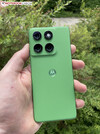















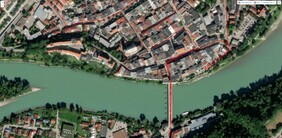


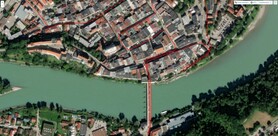
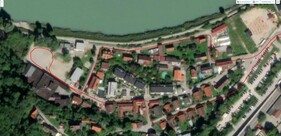








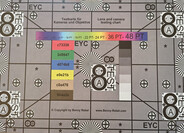





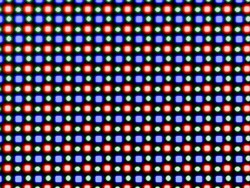
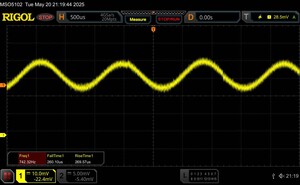





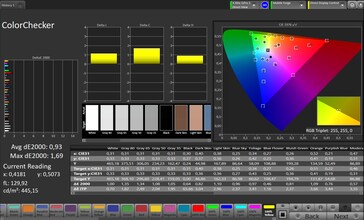
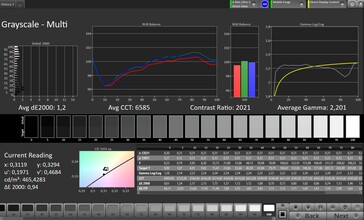
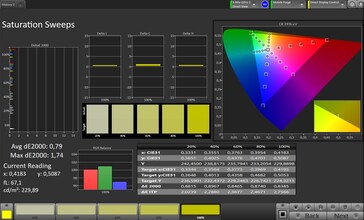
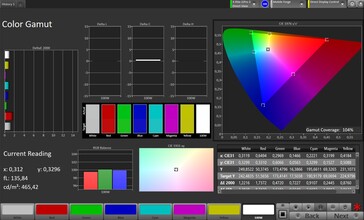
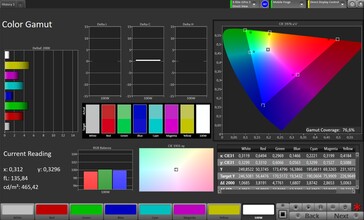

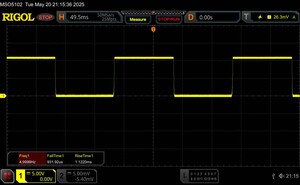
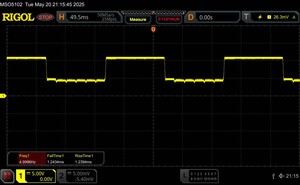






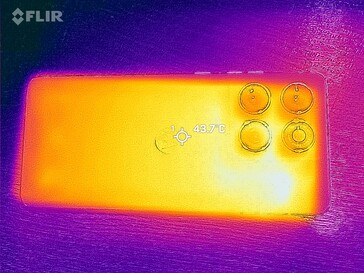
 Total Sustainability Score:
Total Sustainability Score: 





